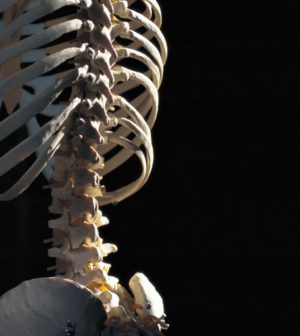- Navigating Your Midlife Crisis: Embracing New Possibilities
- City Raccoons Showing Signs of Domestication
- Mapping the Exposome: Science Broadens Focus to Environmental Disease Triggers
- One Week Less on Social Media Linked to Better Mental Health
- Your Brain Changes in Stages as You Age, Study Finds
- Some Suicide Victims Show No Typical Warning Signs, Study Finds
- ByHeart Formula Faces Lawsuits After Babies Sickened With Botulism
- Switch to Vegan Diet Could Cut Your Greenhouse Gas Emissions in Half
- Regular Bedtime Does Wonders for Blood Pressure
- Dining Alone Could Mean Worse Nutrition for Seniors
Electrical Pulses May Ease Pain From ‘Slipped’ Disc

A new treatment that aims electrical pulses at irritated nerves around the spinal cord appears effective at relieving chronic lower back pain and sciatica, a preliminary study suggests.
The minimally invasive procedure, called image-guided pulsed radiofrequency, eased lingering pain in 80 percent of 10 patients after a single 10-minute treatment. Ninety percent were able to avoid surgery.
“Given the very low risk profile of this technique, patients suffering herniated disc and nerve root compression symptoms may undergo a safe and fast recovery, going back to normal activities within days,” said study author Dr. Alessandro Napoli. He’s an interventional radiologist at Sapienza University, in Rome, Italy.
“In fact,” he added, “one of the dramatic advantages of this technology is that we can perform it in a day-surgery setting, without anesthesia, and [patients] go home the same day.”
Napoli’s study is scheduled for presentation Wednesday at the Radiological Society of North America’s annual meeting, in Chicago. Studies presented at scientific conferences typically haven’t been peer-reviewed or published, and results are considered preliminary.
About 8 in 10 people suffer from lower back pain at some point in their lives, according to study documents. This pain can be due to a herniated disc in the lower spine. Sciatica is radiating leg pain caused by a pinched nerve in the lower spine, which also may be due to a herniated disc.
Also called a slipped or ruptured disc, a herniated disc occurs when the spongy material inside a spinal disc squeezes through its tough outer shell because of aging or injury. This material can press on surrounding nerves, causing pain and numbness or tingling in the legs, according to the American Academy of Orthopaedic Surgeons (AAOS).
Conservative, nonsurgical approaches typically ease symptoms of a herniated disc over time, according to the AAOS. These treatments include rest, gentle exercise, pain relievers, anti-inflammatory drugs, cold or hot compresses and physical therapy.
However, about 20 percent of those with acute low back pain don’t find relief through these measures. That leads some to decide on surgery to remove disc material pressing on their spinal nerves. For these people, Napoli said, image-guided pulsed radiofrequency treatment may become a viable option if larger studies reinforce his findings.
Napoli’s research included 80 people who had experienced at least three months of low back pain from a herniated disc that hadn’t responded to conservative treatments.
Image-guided pulsed radiofrequency treatment uses computed tomography — a CT scan — to help physicians insert a needle to the location of the herniated disc and surrounding nerves. A probe that’s inserted through the needle tip delivers pulsed radiofrequency energy to the area over a 10-minute period, resolving the herniation without touching the disc, Napoli explained.
More than 80 percent of the 80 study participants were pain-free a year after a single treatment. Six people required a second treatment session.
Pulsed radiofrequency has been widely used in pain medicine for other types of chronic pain, Napoli noted.
He said the treatment works by “eliminating the inflammation process” in nerves surrounding the herniated disc, hindering painful muscle contractions. “The aim was to interrupt this cycle and give the body the chance to restore a natural healing,” he added.
Dr. Scott Roberts, a physiatrist with Christiana Care Health System in Wilmington, Del., said the new findings showed “an impressive drop in pain and improvement in function.” However, he noted that the research didn’t include a control group for comparison with people not given the treatment.
“With no control group, we don’t know how much of the improvement we’re seeing would have happened anyway,” Roberts said. “I was very encouraged by [the study] because its results are significant, but it’s far from conclusive without a control group.”
More information
The American Academy of Family Physicians has more on herniated discs.
Source: HealthDay
Copyright © 2025 HealthDay. All rights reserved.










